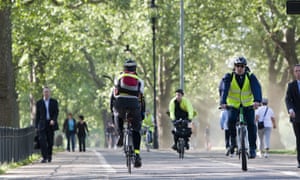Walk more, and walk faster
It’s hard to overstate the benefits of walking. Indeed , it’s hard to find any drawbacks at all, unless you don’t look where you are going (iPhone zombies, put that screen down). A report from the Ramblers Association and Macmillan Cancer Support found that if everyone in England regularly walked for half an hour a day, it could save 37,000 lives a year. It also cuts the risks of type 2 diabetes and heart disease, and has been shown to have protective effects against dementia. We should all do it a lot more.
As with all habits, it’s harder to form than it is to break, but be firm with yourself: rain never hurt anyone. For the competitive at heart, it’s worth looking into one of the new range of high-tech pedometers, such as Jawbone or Fitbit. You can duel with a friend to see who can take the most steps over a given period – or set yourself a daily goal.
Get on your bike – but don’t overfuel

Cycling is a great, low-impact exercise that has the handy benefit of also getting you from A to B. If cycle commuting is impractical or makes you nervous, find a local park route or get on a stationary bike. Start by building confidence and endurance but when you feel ready, throw in some resistance intervals – whether that’s a minute hard, a minute easy at the gym or a hilly route on the road. Study after study has shown that HIIT – high intensity interval training – is a highly effective form of fitness training, and its short albeit-not-very-sweet nature makes it easier to fit into a busy day. But you do have to push hard for those short periods – and remember not to overfuel afterwards. A 20-minute bike ride is great, but doesn’t merit a large slice of cake.
Don’t take it too easy
Many people avoid taking up a new exercise they perceive as high impact or too stressful on their bodies, whether that’s pounding the pavements or lifting weights. But low volume aerobic exercise such as running – at whatever age you take it up – can help increase bone density, which is particularly helpful for women in later life. Strength training can be even more beneficial for maintaining bone density and muscle mass, which also diminishes from middle age. A study in the journal Biogerontology last year recommended that all adults should do resistance exercise, aerobic training and have a higher daily protein intake. All of these serve to preserve – and indeed build – muscle mass. So if you find the cardio machines in the gym boring, talk to one of the trainers about learning how to lift weights.
One habit at a time – and find a sport you love

A sudden radical overhaul of every aspect of your life is highly likely to end a week later in despair (or in the pub). Create mini goals, not unachievable dreams. Start the NHS Couch-to-5k app, rather than Googling ultramarathons. If team sports are more your idea of fun, then find a local league but remember than you need to do more than one five-a-side knockabout a week to really build fitness. Try a range of different classes and activities until one sticks – it might be boxing, or spinning, or 30 lengths of your local pool every morning. Whatever it is, build it into your life until it never even occurs to you that you “don’t have time” for fitness.
Don’t give up if it hurts
The first time you try something new, you might well hurt a bit the next day. That’s just Doms – Delayed Onset Muscle Soreness – and is simply your muscles protesting at being made to work hard. You’d feel it at any age. It’ll last a day or two, then go. Stretch it out – and keep your joints mobile and active. Poor mobility can cause pain, and put you off starting a more vigorous routine (which would, actually, help ease it) and it’s all too easy to have poor mobility if you sit at a desk all day.
Source: Read Full Article
